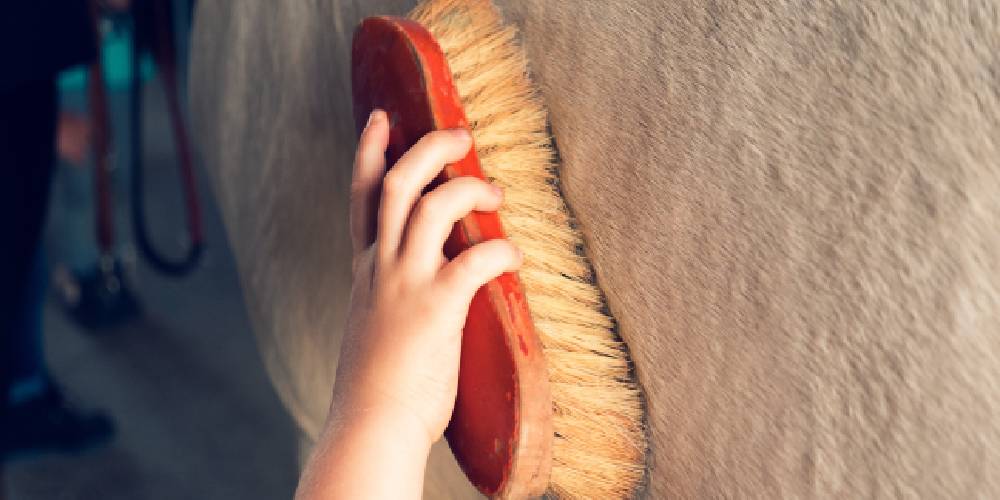Grooming equipment is used by nearly every horse owner on earth. Using these materials helps to keep a horse’s coat and skin clean and healthy, and their mane and tail from tangling and matting. There are several different kinds of grooming materials used including brushes, combs, and hoof picks. What are the different types of grooming supplies and what are they used for?
Types Of Body Brushes & Coat Care
Curry Comb
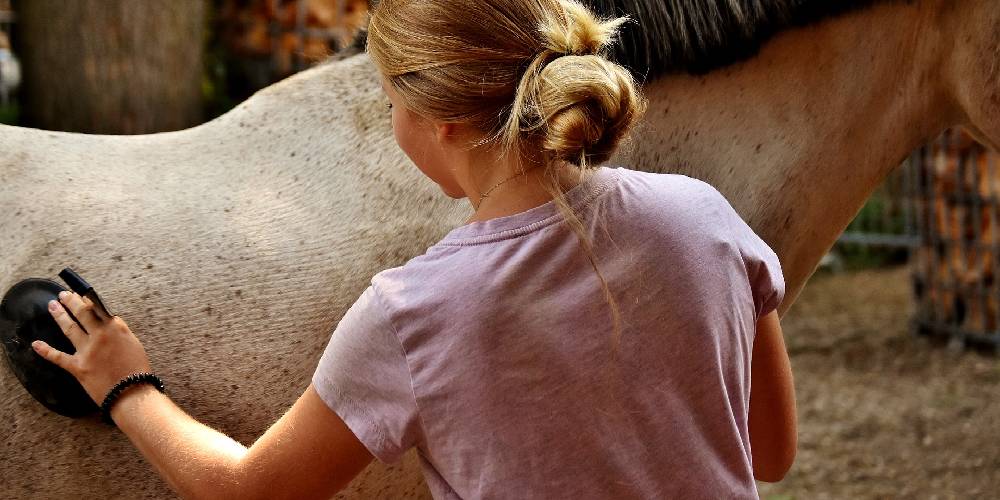
A curry comb is a type of horse brush mainly used on the horse’s body. There are softer more flexible curry combs for use on the horse’s face, but mainly the curry comb is used on the horse’s body.
Most curry combs are circular or oval in shape and are made of rubber. They don’t usually have bristles like other brushes, and if they do they are short and made of a flexible rubber material. Around the outside of the brush itself will be a ring of rubber bumps. There will be at least one more ring of these bumps on the inside of the outer ring.
The curry comb can be used on the head (if used gently), neck, shoulders, chest, barrel, and hindquarters. Don’t use a curry comb on the horse’s legs though as it might be a little too harsh for them. You will rub the curry comb in a circular motion across the whole body.
The purpose of using a curry comb is to loosen up dirt, mud, dander, sweat, and shedding hair from the coat. They work great when horses begin to shed as they help to loosen up a lot of the shedding hair.
You should always use a curry comb on the horse’s body before any other brushes. This way, the curry comb can loosen all the things in the coat and the brushes can brush it off.
Curry combs are made in nearly every color imaginable and come in a number of shapes and sizes.
Body Brush Or Dandy Brush
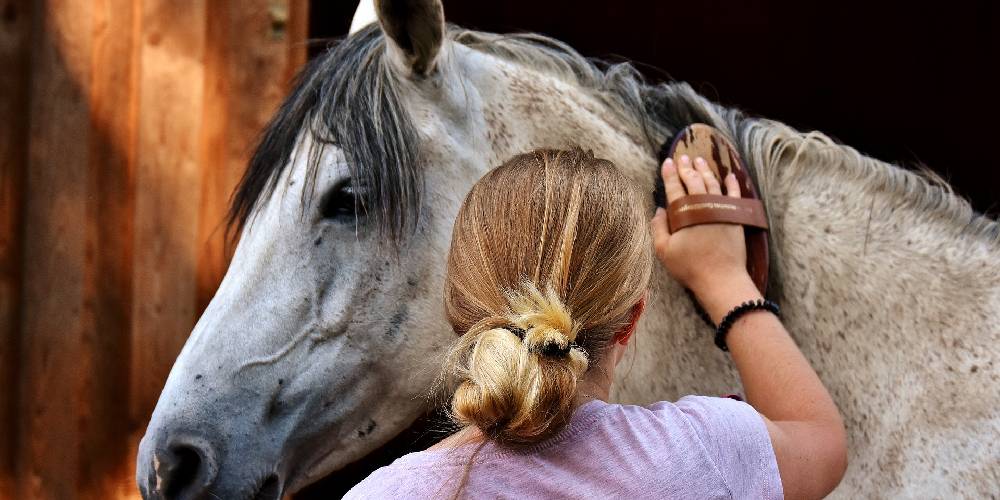
A body brush is a brush made of a solid base handle and several bristles. They are only used on the horse’s body. They can be used on their legs if the bristles are soft enough.
Most body brushes are a rounded oval or rectangular shape and have a plastic or wooden base where they are held. Sometimes, there is a strap that goes over the top of the user’s hand to help them hold onto the brush better if it is a awkward size or shape. The bristles of body brushes can be made of animal hair, plastic, or plant fibers like Tampico.
The body brush can be used on the neck, chest, shoulders, barrel, and hindquarters. They can also be used on the legs if the bristles are soft enough and aren’t too harsh for this part of their body. Do not use this brush on their face as it is too rough.
When using a body brush, you will brush with the horse’s coat, meaning brushing with the hair in whatever direction it falls naturally. I recommend brushing front to back, top to bottom. With this in mind, you would start brushing the horse from the top of the neck and go down across the rest of the body until you’re at the bottom of the hindquarters, just above the gaskin.
The purpose of a body brush is to remove and brush away surface dirt, sweat, dander, and mud. It is a great tool to use after you go in with the curry comb because it removes all that resurfaced dirt and buildup brought up by the curry comb.
There are a lot of different shapes, sizes, and colors of body brushes.
Face Brush
Face brushes look like little body brushes. Like body brushes, they have a solid base and handle and many bristles. They are intended only for brushing the horse’s face and are made soft enough for this sensitive part of their body.
Most face brushes are oval or rectangular in shape and only measure to be around three inches long and one inch wide. The bristles are extremely soft and fine so they are most commonly made of a fine plastic material or animal hair.
The face brush can be used anywhere on the horse’s body, but is most commonly seen used on the ears, over the eyes, on the forehead, on the nose, on the cheeks, and on the sides of the horse’s head.
Face brushes can be used at any stage of the grooming process, but I mainly use them after I’m done with the horse’s body. With face brushes, brush along with the horse’s hair and start at the top of their head and work your way down to their muzzle.
The purpose of the facial brush is to remove all dirt, hair, sweat, and other buildup from the horse’s face.
There are several facial brushes seen in a ton of colors and shapes, but all of them will be small.
Shedding Blade
Shedding blades are tools that come in a variety of designs. This tool is intended to remove and scrape off shed horse hair from their coat. The blade has a serrated edge and can be straight across or curved.
There are three main designs of shedding blades seen. There are ones that consist of one or two straight blades attached to a handle. There are others that consist of two or three circular pieces of metal attached to a handle. Lastly, there are some that consist of one or two pieces of metal that are curved over and can attach together. These ones specifically can detach from each other and form two handles and make a new shedding tool.
Shedding blades, because of their harshness, should only be used on the neck, shoulders, chest, barrel, and hindquarters. They shouldn’t be used on face or legs because they are too hard to use on these sensitive areas.
Shedding blades can be used before or after the body brush is used. They shouldn’t be used straight away as the blade can get gummed up and coated with horsey dandruff if the horse hasn’t been curried.
To use a shedding blade, go with the grain of the horse’s hair and follow it in whatever direction it goes. Start top to bottom and front to back like you would in any other grooming situation. You can go over sections several times. If horse’s are shedding, a lot of hair will be coming off of them.
The three types of shedding blades I mentioned are all made of metal, though some will have a wooden or plastic handle for the user to hold.
Soft Bristle Brush
A soft bristle brush can be a body brush or face brush. They are brushes that have soft flexible bristles and are great for relatively clean horses who need a sweat mark smoothed over or horses that just have a little dust here and there.
Hard Bristle Brush
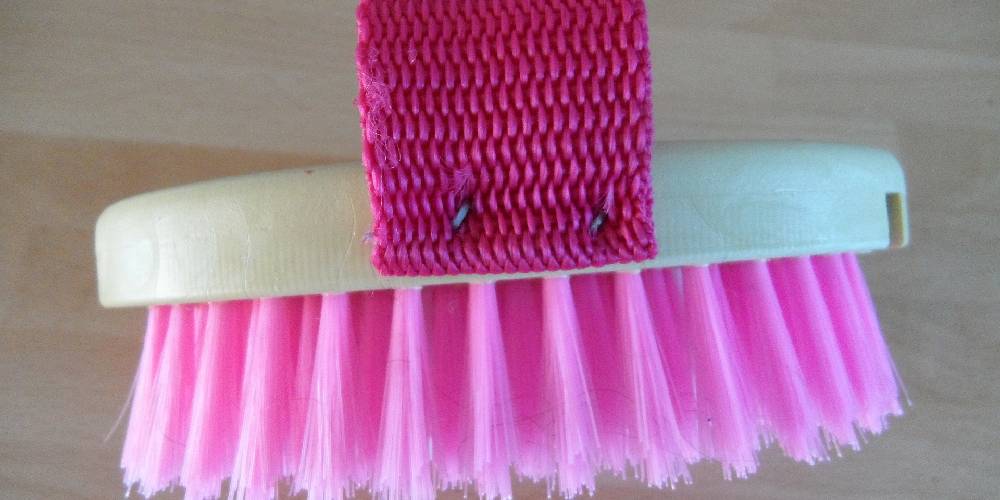
A hard bristled brush is usually a body or dandy brush. They are brushes with coarse rough bristles and are great for removing mud and other encrusted buildups. Hard bristle brushes should not be used on sensitive parts of the horse such as their face and legs.
It is also recommended not to use one if a horse has sensitive skin or if a horse has just been clipped.
Sweat Scraper
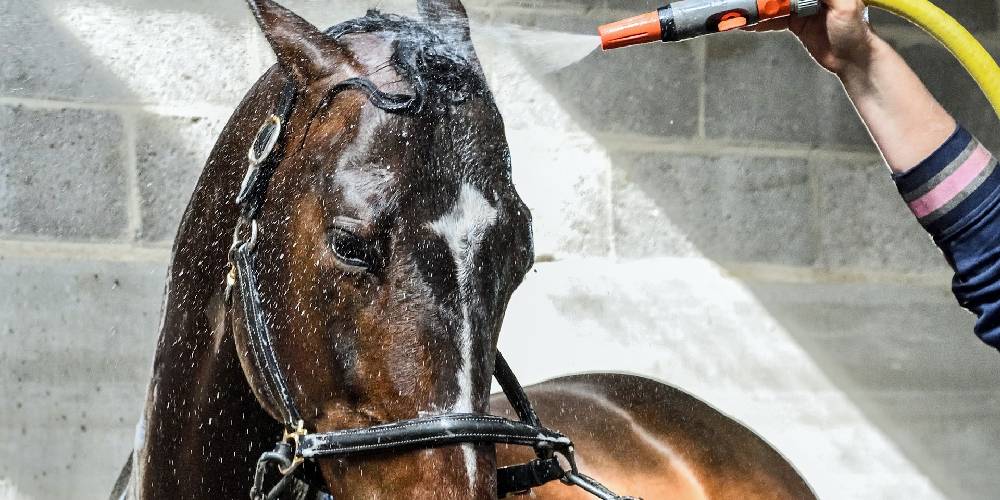
Sweat scrapers are great tools made of rubber or plastic that are used to scrape water and sweat out of the horse’s coat. They are mainly used after a horse has an intense workout to help remove sweat, or to remove excess water from a horse’s coat after it has been bathed or rinsed off.
There are two main designs of sweat scrapers. Straight ones and curved ones. Straight ones are mainly made of plastic and one of the sides of the scraper is used to scrape the sweat or water out of the horse’s coat. The curved ones have a plastic handle attached to a curved piece of rubber which is used for the same purpose. The curved ones remind me of mini squeegees for horses.
To use a sweat scraper, press the scraping edge into the horse’s coat horizontally and run it up to down and top to bottom.
These scrapers can come in nearly every color imaginable.
Hoof Cleaning Materials
Hoof Pick

Hoof picks are of the most important tools used in the horse world. The reason for this is simply the saying, ‘No hoof, no horse.” This means that hoof health is essential to a horse’s survival.
Hoof picks are made usually of metal and consist of a handle and a hook. The hook is used to scrape out dirt, manure, and rocks from the hoof, and the handle is to offer a strong comfortable grip to its user.
Hoof picks should ONLY be used on the horse’s hooves. There is no need for them outside of hoof care.
There are mainly two hoof pick designs. One of them is the standard metal hoof pick consisting of a metal piece with a hook at the end. The other kind consists of a plastic handle, a metal hook on the end, and a hoof brush on the back of the hook. Both of these designs do great in cleaning the hoof.
Hoof picks can come in a number of colors. They are usually around four to six inches tall and have a one-inch hook piece.
When using a hoof pick, you will want to remove all dirt, manure, and rocks from the hoof. You should clean especially well along each side of the horse’s frog as that is a prime area for thrush to develop.
Hoof Brush
Hoof brushes are mainly found on the ends on hoof picks like I mentioned before. They are used to finish up the hoof after picking and help to remove loose dirt from the hoof.
Mane & Tail Care
Comb
Horses have combs just like people do. They have both thin combs and wide tooth combs for the horse’s mane and tail. Wide-tooth combs are more popularly used in horses as their hair is much thicker and coarser than that of people.
Horse combs come in a rectangular shape and are usually about two inches tall and six to ten inches long. Wide strong teeth are the most common found on combs as they are much stronger and more durable than the thin ones of a fine-tooth comb.
Combs should only be used on the horse’s mane and tail. This is because the comb is too harsh and awkwardly shaped to work on the horse’s body.
The purpose of using a comb is basically to detangle and smooth out the mane and tail. It is a better tool to use on the mane as the mane is usually thinner and more manageable than the tail. Still, hair brushes are pore popularly used unless when giving a haircut.
Combs are used to brush through the mane and tail to remove knots and tangles. Sometimes, combs are used to help when trimming a horse’s mane or tail as they offer a straight edge to cut along.
Horse combs can come in so many colors that I wouldn’t even be able to name them all.
Hair Brush
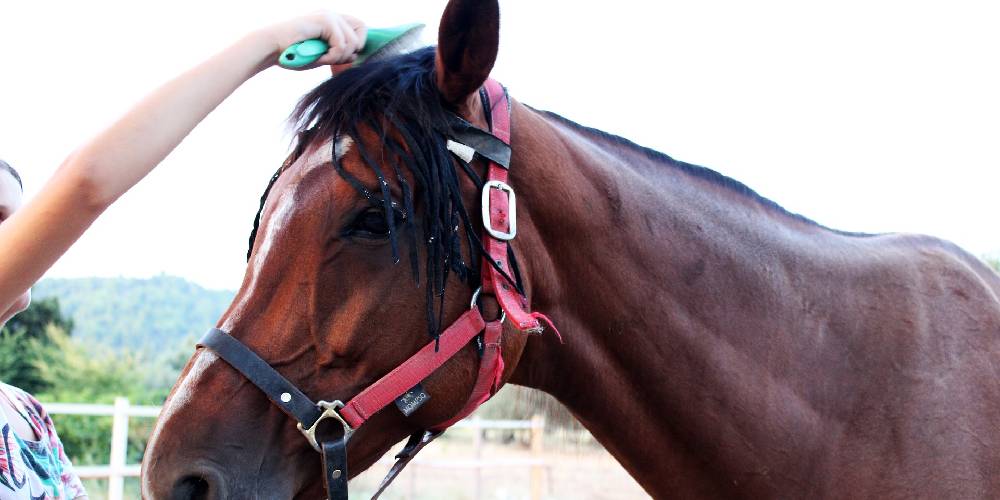
Horses use hair brushes just like people do! I love to use brushes on horse’s manes and tails over combs because it runs through them and detangles their manes and tails so much better than combs do.
They look almost identical to those that people would use and they can come in a lot of different colors. I actually use one at a barn I ride at that has rainbow bristles!
Thinning Knife
A thinning knife looks kind of like a comb, but in between the teeth, there is a sharp edge for cutting the hair. To cut the hair, most commonly the mane. You will tease the mane by combing against the hair after grabbing a piece. You then will wrap the hair around the knife and pull the knife and hair hard against each other to cut the hair.
Thinning Scissors
Thinning scissors are kind of like thinning knives only they con’t involve pulling the main. They are scissors with one blade of the scissors carrying teeth like a comb. This causes the scissors not to cut all of the hair in that specific area. These are a great tool to use when thinning out a thick mane to allow fro easier braining, especially for a horse show.

